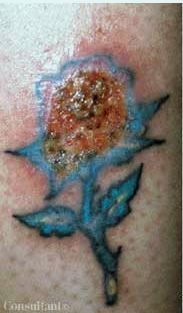Infected Tattoo in a Patient with Diabetes
A 32-year-old woman with insulin-dependent diabetes noted a painful erosion at the site of "the rose tattoo," which she had gotten 5 days before.

A 32-year-old woman with insulin-dependent diabetes noted a painful erosion at the site of “the rose tattoo,” which she had gotten 5 days before. A culture isolated Staphylococcus aureus, confirming the clinical impression of staphylococcal cellulitis. Dr David L. Kaplan of Overland Park, Kan, writes that this diagnosis was not entirely unexpected, since patients with diabetes mellitus are predisposed to staphylococcal infection. An oral cephalosporin cleared the cellulitis, leaving the flower blooming but a bit distorted.
The tattoo artist blamed the cellulitis on the patient’s failure to take proper care of the wound site. However, the lack of recurrent infections in the patient’s history indicates that she probably was not a S aureus nasal carrier, and the infection grew from a new source. Despite the artist’s refusal to assume responsibility for the infection, we advised the patient to report him to the health department and the state board of licensing.